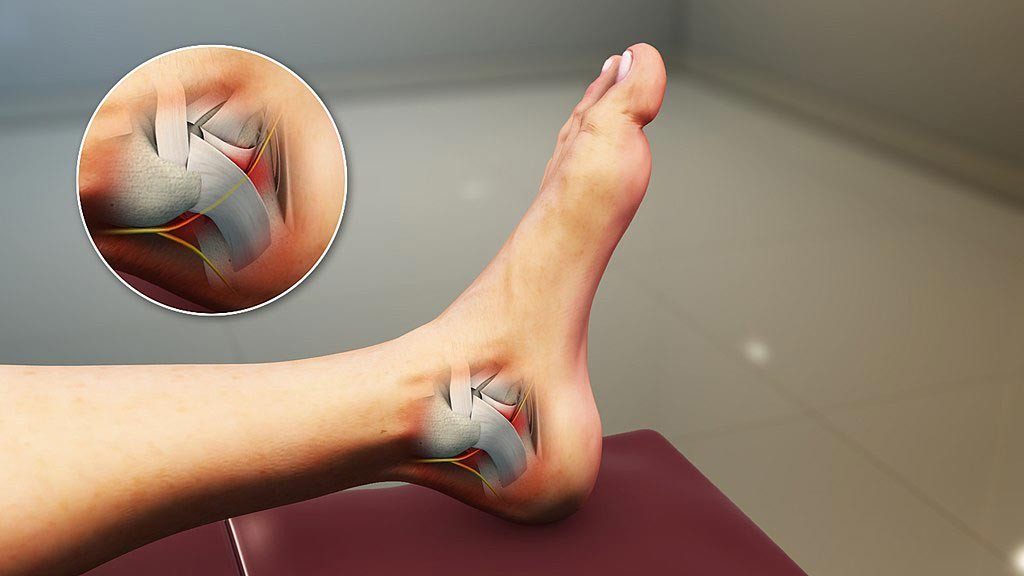Definisi
Tarsal tunnel syndrome adalah sebuah kondisi ketika saraf tibialis tegang atau tertekan saat melewati terowongan tarsal. Saraf tibialis mempersarafi otot-otot pada tungkai bawah dah kaki. Terowongan tarsal, yang dilewati saraf tersebut, terletak pada pergelangan kaki dan tersusun oleh tulang-tulang pada tumit dan ligamen-ligamen yang menyambungkan berbagai struktur pada kaki.
Penyebab
Tarsal tunnel syndrome disebabkan oleh terjepitnya saraf tibialis saat melewati terowongan tarsal. Penjepitan ini dapat disebabkan oleh berbagai kondisi, baik kondisi di luar struktur terowongan tarsal kaki (ekstrinsik) atau di dalam struktur tersebut (intrinsik). Penyebab ekstrinsik tarsal tunnel syndrome dapat berupa sepatu yang terlalu kecil untuk kaki, trauma, kelainan bentuk tungkai seperti kaki bengkok berbentuk seperti huruf O atau X, peradangan sendi, bekas luka operasi, bengkak pada kaki, diabetes, dan sebagainya. Sementara itu, penyebab instrinsik tarsal tunnel syndrome dapat berupa peradangan pada tendon (struktur yang menghubungkan tulang dan otot), pengapuran di sekitar saraf, benjolan tulang yang muncul dan menekan saraf, pembesaran pembuluh darah balik, serta massa seperti lipoma, kista ganglion, dan berbagai jenis tumor lainnya.
Faktor Risiko
Faktor risiko tarsal tunnel syndrome dapat berupa penyakit yang menyerang tubuh secara keseluruhan seperti diabetes melitus, hipotiroidisme (kadar hormon tiroid yang rendah), gout (peradangan pada sendi yang disebabkan oleh kadar asam urat yang tinggi), dan hiperlipidemia (kadar lemak yang tinggi dalam darah). Sebanyak 43% dari seluruh penderita tarsal tunnel syndrome memiliki riwayat trauma yang terjadi sebelum gejala muncul, seperti keseleo pada pergelangan kaki.
Gejala
Gejala tarsal tunnel syndrome dapat berupa:
- Nyeri seperti ditusuk-tusuk, dapat menjalar ke telapak kaki dan betis. Nyeri dapat diperparah dengan menggerakan telapak kaki ke atas atau ke bawah. Oleh karena itu, keluhan biasanya semakin parah saat berjalan atau berdiri, atau setelah aktivitas fisik, dan membaik dengan istirahat.
- Baal atau kebas.
- Rasa kesemutan atau terbakar pada kaki.
- Kelemahan otot pada kaki.
Diagnosis
Diagnosis tarsal tunnel syndrome sangat tergantung pada riwayat penyakit dan pemeriksaan. Dokter dapat menanyakan Anda mengenai riwayat penyakit yang berkaitan dengan masalah saraf pada kaki, seperti diabetes melitus dan hipotiroidisme. Selain itu, dokter dapat pula menanyakan riwayat penggunaan obat-obatan seperti obat pelebar pembuluh darah, obat asam urat, obat antikejang, obat antimalaria, obat sakit kepala, obat mual, kemoterapi kanker, serta vitamin. Selain itu, dokter dapat pula menanyakan riwayat paparan terhadap HIV/AIDS, penggunaan vitamin, penyakit Lyme (penyakit yang menyerang saraf, diakibatkan oleh gigitan kutu), serta riwayat bepergian keluar negeri untuk mengetahui paparan terhadap penyakit lepra.
Setelah itu, dokter dapat melakukan beberapa pemeriksaan langsung. Kaki Anda dapat digerakkan untuk mengetahui posisi nyeri serta penjalaran nyerinya. Pergelangan kaki dapat lebih hangat daripada struktur di sekitarnya. Pada kondisi yang parah, dapat ditemukan pengecilan otot betis. Dokter dapat melakukan pemeriksaan dengan mengetuk lembut pergelangan kaki. Selain itu, pemeriksaan raba dapat pula dilakukan untuk membandingkan sensasi raba pada kedua kaki, serta mencari adanya penurunan sensasi pada kaki yang bermasalah.
Selain pemeriksaan langsung, pemeriksaan laboratorium juga dapat dilakukan. Pemeriksaan ini dapat berupa urinalisis, gula darah puasa, hemoglobin A1c (yang mengikat gula), ureum, kreatinin, pemeriksaan darah lengkap, laju endap darah, dan kadar vitamin B12. Jika dicurigai ada gejala penyakit autoimun seperti artritis reumatoid, pemeriksaan Rheumatoid Factor (RF) dapat pula dilakukan.
Pencitraan pada pergelangan kaki dapat pula dilakukan untuk mencari struktur yang menjepit saraf tibialis. Pencitraan dapat dilakukan dengan ultrasonografi (USG), foto rontgen polos, atau Magnetic Resonance Imaging (MRI). Foto rontgen polos dapat mendeteksi adanya kelainan struktur pada kaki, patah tulang, massa pada tulang, serta benjolan tulang. Sementara itu, MRI dapat digunakan untuk melihat adanya peradangan pada tendon atau adanya massa seperti tumor.
Pemeriksaan elektromiografi (EMG) dapat pula dilakukan. Pemeriksaan ini dilakukan untuk mengetahui hantaran listrik pada saraf dan otot, serta kecepatannya. Pemeriksaan ini dapat membantu mencari kelainan pasti pada saraf tibialis.
Tatalaksana
Tata laksana tarsal tunnel syndrome sangat tergantung dari penyebab, kehilangan fungsi, serta pengecilan otot, dan dapat ditangani dengan atau tanpa pembedahan. Tujuan terapi tanpa pembeahan adalah menurunkan nyeri, radang, dan stres pada jaringan. Anda dapat diresepkan obat antinyeri biasa atau khusus untuk saraf. Selain itu, terapi lainnya dapat berupa terapi fisik untuk memperkuat otot dan menurunkan nyeri dengan menurunkan stres mekanik. Sepatu khusus dapat pula digunakan untuk memperbaiki kesalahan bentuk kaki dan melegakan terowongan tarsal. Jika tarsal tunnel syndrome disebabkan oleh kista ganglion, penyedotan kista dengan bantuan USG dapat dilakukan. Jika disebabkan oleh pembengkakan pada kaki, penyuntikan obat steroid dapat dilakukan untuk menurunkan peradangan pada pergelangan kaki.
Pembedahan disarankan jika terapi di atas gagal memperbaiki kondisi tarsal tunnel syndrome, atau jika bertambah parah, atau jika penyebab saraf terjepit dapat diambil lewat pembedahan. Pembedahan ini dilakukan untuk melonggarkan terowongan tarsal. Tingkat keberhasilan pembedahan dapat berkisar antara 44-96%.
Setelah terapi dimulai atau pembedahan dilakukan, Anda dapat diminta untuk tidak melakukan aktivitas yang membebani pergelangan kaki selama 3 minggu agar penyembuhan optimal. Namun, kaki harus dibiasakan untuk bergerak secepat mungkin untuk mencegah pembentukan jaringan bekas luka yang tidak dapat hilang. Jaringan tersebut dapat berpotensi menyebabkan tarsal tunnel syndrome. Terapi fisik sangat penting agar kekuatan dan ruang gerak pergelangan kaki dapat dipertahankan untuk melegakan nyeri. Penggunaan sepatu yang nyaman juga sangat penting untuk meningkatkan pemulihan tarsal tunnel syndrome.
Komplikasi
Jika tarsal tunnel syndrome tidak diterapi, dapat terjadi masalah pada saraf tibialis dan cabang-cabangnya. Nyeri dapat bertahan terus-menerus. Pada kondisi yang lebih parah, dapat terjadi kelemahan dan pengecilan otot betis. Sementara itu, komplikasi pembedahan dapat berupa kegagalan penyembuhan luka, infeksi, dan terbentuknya bekas luka. Pelonggaran terowongan tarsal dapat pula tidak cukup untuk melegakan nyeri dan gejala lainnya. Tidak hanya itu, pada saat pembedahan, dapat pula terjadi luka pada saraf, yang sangat merugikan fungsi kaki.
Pencegahan
Pencegahan tarsal tunnel syndrome sangat terkait dengan penyebabnya. Jika tarsal tunnel syndrome didahului oleh penyakit yang menyerang seluruh tubuh seperti diabetes melitus, kepatuhan terapi sangat penting untuk mencegah masalah pada saraf terjadi. Selain itu, penggunaan sepatu yang nyaman sangat penting untuk mencegah tarsal tunnel syndrome. Trauma pada pergelangan kaki sulit dicegah, namun jika terjadi, penanganan awal untuk menurunkan peradangan sangat diperlukan untuk mencegah tarsal tunnel syndrome.
Kapan harus ke dokter?
Segeralah ke dokter apabila Anda mengalami nyeri pada pergelangan kaki seperti ditusuk-tusuk, disertai rasa terbakar, kesemutan, dan baal, serta menjalar ke telapak kaki dan betis. Nyeri ini sangat khas untuk saraf, dengan penjalarannya khas untuk saraf tibialis. Penyebab gejala ini belum tentu merupakan tarsal tunnel syndrome, namun kondisi-kondisi serupa dapat membahayakan kaki Anda.
- dr Ayu Munawaroh, MKK
Kiel, J., & Kaiser, K. (2021). Tarsal Tunnel Syndrome. Retrieved 6 December 2021, from https://www.ncbi.nlm.nih.gov/books/NBK513273/
Persich, G. (2020). Tarsal Tunnel Syndrome: Background, Anatomy, Pathophysiology. Retrieved 6 December 2021, from https://emedicine.medscape.com/article/1236852-overview
Tarsal Tunnel Syndrome. (2021). Retrieved 6 December 2021, from https://www.hopkinsmedicine.org/health/conditions-and-diseases/tarsal-tunnel-syndrome












